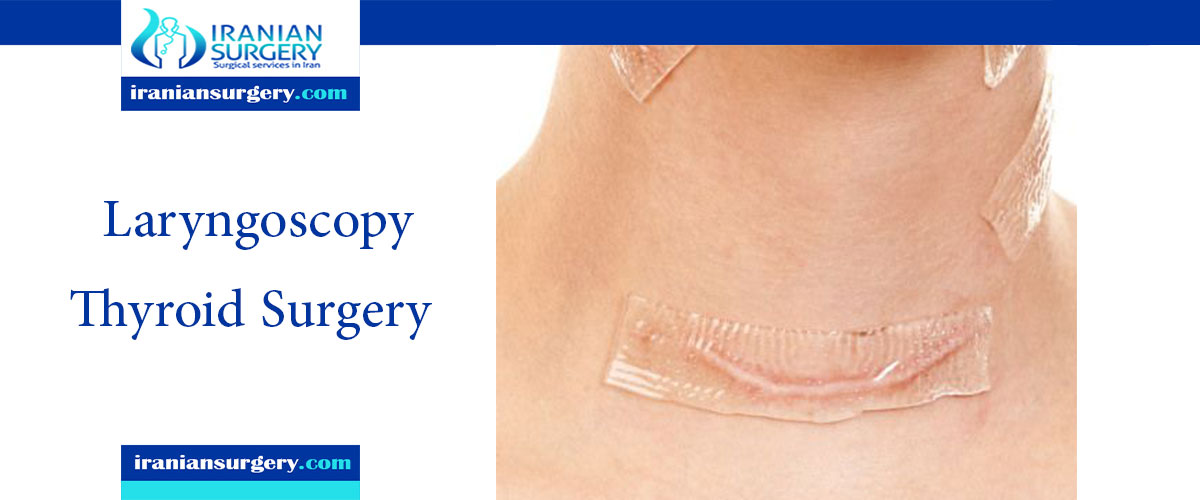Laryngoscopy thyroid surgery

Can an ENT do thyroid surgery?
How long does it take for vocal cords to heal after thyroid surgery?
How long does surgery take to remove your thyroid?
Is thyroid surgery a major surgery?
How long are you in the hospital after thyroid surgery?
Is thyroid surgery serious?
Thyroid tumors can sometimes affect the vocal cords. If you are going to have surgery to treat thyroid cancer, a procedure called a laryngoscopy will probably be done first to see if the vocal cords are moving normally. For this exam, the doctor looks down the throat at the larynx (voice box) with special mirrors or with a laryngoscope, a thin tube with a light and a lens on the end for viewing.
A retrospective chart review of a 3-year, single-surgeon experience was performed. Records of patients undergoing thyroid surgery were reviewed for patient voice complaints, prior neck surgery, surgeon-documented voice quality, and results of laryngoscopy.
Background
Preoperative and postoperative laryngoscopy has been recommended for diagnostic and forensic reasons as a standard procedure in all patients who undergo thyroid surgery. The aim of this study was to find a more selective approach by defining patients at risk of developing vocal fold palsy (VFP).
Read more about: Thyroidectomy complications
Results
Of 464 patients, 6% had abnormal laryngoscopy findings, including 11 cord paralyses (2%). Preoperatively, 39% of patients had voice complaints, but only 10% had a corresponding abnormality on laryngoscopy. Only 4% of patients had a surgeon-documented voice abnormality with 72% corresponding abnormalities on laryngoscopy, including 8 cord paralyses. When eliminating patient voice complaints and using only history of prior neck surgery and surgeon-documented voice abnormality as criteria for preoperative laryngoscopy, only 1 cord paralysis is missed and sensitivity (91%) and specificity (86%) were high. Also, when compared with routine laryngoscopy, 84% fewer laryngoscopies are performed.
Read more about: Thyroidectomy types
Conclusion
When using patients' voice complaints as criteria for preoperative laryngoscopy, the yield is low. We recommend using surgeon-documented voice abnormalities and history of prior neck surgery as criteria for preoperative laryngoscopy.
Can an ENT do thyroid surgery?
An ear, nose and throat (ENT) professional is able to treat a number of different thyroid conditions. General surgeons still perform the majority of thyroid surgery (83%) but ENT surgeons now perform significant numbers (15.4% of all cases), which translates to 1499 cases per annum.
Read more about: Thyroidectomy Surgery in Iran
How long does it take for vocal cords to heal after thyroid surgery?
Typically, your physician will prescribe three to seven days of voice rest after surgery. There are two sets of nerves near the thyroid gland that help control the vocal cords. These are the recurrent laryngeal nerve and the external branch of the superior laryngeal nerve. Damage to a recurrent laryngeal nerve can cause you to lose your voice or become hoarse. Temporary hoarseness, voice tiring, and weakness can occur when one or more of the nerves are irritated during the operation or because of inflammation that occurs after the surgery. This usually gets better within a few weeks, but can take up to 6 months to resolve. Even in the rare chance of having a permanently hoarse voice, there are things that can be done to improve voice quality. An otolaryngologist or Ear, Nose, & Throat specialist can be very helpful in determining the specific problem and can perform different procedures to help improve voice quality.
Read more about: Is papillary thyroid carcinoma dangerous?
How long does surgery take to remove your thyroid?
Thyroidectomy usually takes one to two hours. It may take more or less time, depending on the extent of the surgery needed.
Read more about: Thyroid cancer treatment
Is thyroid surgery a major surgery?
Thyroidectomy is the surgical removal of all or part of your thyroid gland. Your thyroid is a butterfly-shaped gland located at the base of your neck. A thyroidectomy is a common but major surgery with serious risks and potential complications. You may have less invasive treatment options.
Read more about: Thyroidectomy scar
How long are you in the hospital after thyroid surgery?
You will be in the hospital usually one night. Your surgeon will explain your specific surgery and why it is recommended in your case. As with any surgical procedure, there are risks involved. There is a risk of bleeding, but this is very low.
Read more about: Parathyroidectomy
Is thyroid surgery serious?
Thyroid surgery is usually a safe operation and associated with a low rate of complications. As with every major surgery, thyroid surgery carries the risk of an adverse reaction to general anesthetic. Other risks include heavy bleeding and infection.
Risks specific to thyroid surgery rarely occur. However, the two most common risks are:
- damage to the recurrent laryngeal nerves (nerves connected to your vocal cords)
- damage to the parathyroid glands (glands that control the level of calcium in your body)
Read more about: Common side effects of thyroid cancer treatment:

